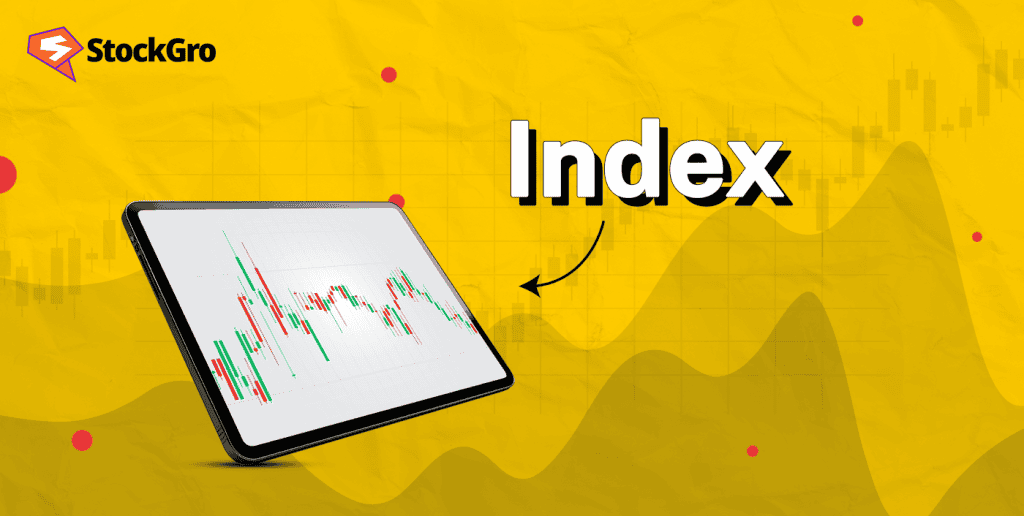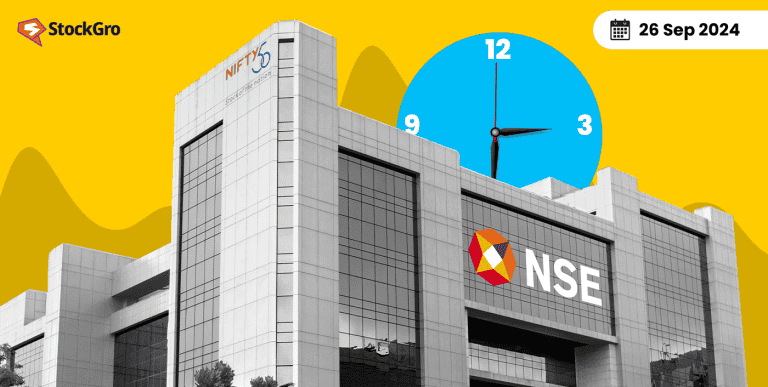
The Nifty 50, a benchmark index comprising India’s top companies, has recorded positive gains in 20 of the past 25 years. These companies collectively represent about 57% (as of March 2024) of the free-float market capitalisation on the National Stock Exchange of India.
Wondering how to capitalise on this broad economic representation? There are several ways to do so, each offering unique benefits. Continue reading to uncover the different strategies for accessing the stock market through index-based investments.
What is a stock market index?
A stock market index serves as a statistical tool, capturing the behaviour of a selected group of shares within a market segment. It’s not merely a number; it reflects the overall health of specific industries or the broader economy. The primary aim is to distil complex price fluctuations into a more digestible form for investors.
What defines an index? It may focus on firms of similar market size or a particular sector like pharmaceuticals or finance. Larger firms tend to have a greater influence on these metrics, impacting the overall reading when their stock prices shift.
In India, prominent examples include the Nifty 50 and BSE Sensex. These indicators aggregate data from top-listed firms, offering investors a simplified way to gauge the economic pulse without getting lost in individual stock performance
You may also like: Coming of age of India’s beloved – Nifty
How to invest in indices?
There are four main ways to invest in indices. They are:
Direct Indexing (self-replicating the index)
Indexing involves constructing a portfolio that mirrors the companies within a specific market benchmark, such as the Nifty 50. You buy the same securities and in the same ratios as those in the benchmark itself, aiming to track its movement.
However, it’s not always straightforward. As the composition of these benchmarks changes, you’ll need to frequently adjust your holdings, which can lead to higher transaction costs and operational complexity.
Index derivatives: Futures & options
Another approach to investing in indices is through derivatives like futures contracts and options, which allow you to tap into market movements without directly holding individual stocks.
Futures
With a futures agreement, you commit to buying or selling an index at a specific value, with the deal to be settled on a future date. If you believe the particular index will increase, you might take a long position. On the other hand, if you predict a decline, you would go short.
Options
Options provide a right, but not a requirement, to buy or sell an index at a predetermined level before the expiry date. You would typically use a call when expecting upward momentum and a put when anticipating a fall.
Both methods demand careful oversight. Each carries its own cost and complexity, but with skill, these instruments can be powerful.
To know more: Unlocking the power of index futures: A beginner’s guide
Index mutual funds
Currently, as of August 2024, there are 230 schemes available.These investment instruments provide another practical way to gain exposure to a broad range of companies. Instead of trying to outperform, these mutual funds mirror specific indices. Aligning their portfolios to match the companies within the index.
These funds are unique in that they don’t require active management. Instead of constantly making investment decisions, they automatically adjust their holdings to reflect any changes in the index. If a company enters or exits, the fund reshuffles accordingly, ensuring its composition remains aligned. This hands-off approach not only simplifies the process but also significantly cuts down on operational costs.
One key benefit is the lower expense ratio. Since the fund doesn’t require frequent trades or in-depth analysis, the overall fees are kept to a minimum, making it an economical choice for those looking to grow their wealth over time without incurring high costs.
Exchange traded funds/ ETFs
These funds aim to reflect the performance of indices by holding the same assets in proportion. Unlike mutual fund counterparts, they trade continuously on stock exchanges, allowing investors to buy or sell them throughout the day.
What makes ETFs stand out is their price fluctuation during market hours, providing opportunities to respond to price changes as they occur. This intraday trading capability offers an edge over traditional funds, which settle transactions only at day’s end.
Liquidity is another strong feature of ETFs. With transactions happening on exchanges, buying or selling is quick and easy. Additionally, investing in an ETF gives you exposure to a wide basket of companies in one go, offering diversification across an entire index.
Why invest in stock market indices?
1. Wide coverage, lower individual risk
Instead of investing into a single company, index funds or ETFs offer access to multiple stocks across sectors. This strategy dilutes the risk, ensuring that the poor performance of one stock won’t derail your entire investment.
2. Affordable and efficient
One of the key benefits of index funds is the lower cost involved. Index-tracking doesn’t require heavy management, which translates to fewer fees. Over the long term, this can significantly improve your net returns.
3. Aligning with broader trends
When you buy into an index, you’re effectively capturing the overall movement of the economy or industry it represents. It removes the guesswork of picking individual shares, allowing you to grow your wealth alongside the market’s upward trajectory.
4. Evaluating success
indices act as benchmarks, offering a way to gauge the success of your overall strategy. If you consistently underperform the chosen benchmark, it’s a signal that your approach might need refining.
Also read: India’s first electric vehicle index: What you need to know
Bottomline
Stock index investments provide a structured approach to participating in overall economic trends. With options ranging from ETFs to mutual funds and derivatives, each method suits different styles of investing. Evaluate your financial objectives and risk appetite carefully to determine the most suitable strategy.
FAQs
- Can you invest directly in indices?
You can’t directly buy an index since it’s just a benchmark. However, you can invest in vehicles that mirror its performance. Options include mutual funds, ETFs, and derivatives, which replicate the index’s value. These tools allow you to follow the same price trends as the index’s underlying assets. Choose based on your strategy.
- Are indices a good investment?
Putting money into indices can work well for those seeking stability. They provide access to a wide range of companies, which helps manage risk. Fees tend to be lower because they don’t need constant supervision. Over the years, they generally align with the economy’s overall growth. That said, they won’t deliver big short-term gains, as they mirror broad trends. This type of investment fits best for those looking for gradual, long-term returns without daily involvement.
- How do I choose a stock market index?
Start by identifying which part of the market interests you most. Some benchmarks focus on established firms, while others highlight emerging industries. Consider the sectors represented, like finance or energy. Review historical trends, but don’t base decisions solely on them. Think about your comfort with risk and how it fits your overall investment plan. Make sure the selected benchmark aligns with what you’re aiming to achieve, and understand how its components contribute to overall movement.
- Can we buy NIFTY 50?
It’s not possible to buy Nifty 50 directly, as it’s only a benchmark. However, you can invest in mutual funds or ETFs designed to mirror its behaviour. Alternatively, some investors use derivatives, such as futures or options, which are based on the index. These methods provide access to the performance of all 50 companies without purchasing each stock individually. While you can’t own the index itself, you can still benefit from its overall movement.
- How do I start investing in indices?
Choose a market benchmark that aligns with your objectives. You can opt for an ETF or mutual fund that tracks it. Another approach is direct indexing, where you purchase individual shares representing the benchmark. For more advanced strategies, you might consider futures or options. Open a brokerage account that offers these instruments. Begin with an amount that fits your comfort level and consistently review your portfolio to ensure it meets your goals.

